Hawaii has a number of bodies of fresh water. From natural lakes to man-made reservoirs and fishponds, there are plenty of spots to explore. Tourists and locals can discover the ancient history of Hawaiian culture and religion through learning about some of its magical water systems.
Because Hawaii is merely a series of small landmasses, there isn’t enough room for giant mountain ranges. This makes it essentially impossible for large natural lakes to form. Many years ago, ancient Hawaiians built what are known as fishponds to provide fish during seasons when they wouldn’t be able to utilize the ocean.
Most of the ancient fishponds are now gone; however, a few have survived and been preserved for modern viewing and exploration. Hawaii is also home to the third-highest lake in the United States. While the beaches, surfing, and ocean surrounding the islands provide an absolutely amazing experience, don’t forget to also check out the freshwater systems!
Waita Reservoir
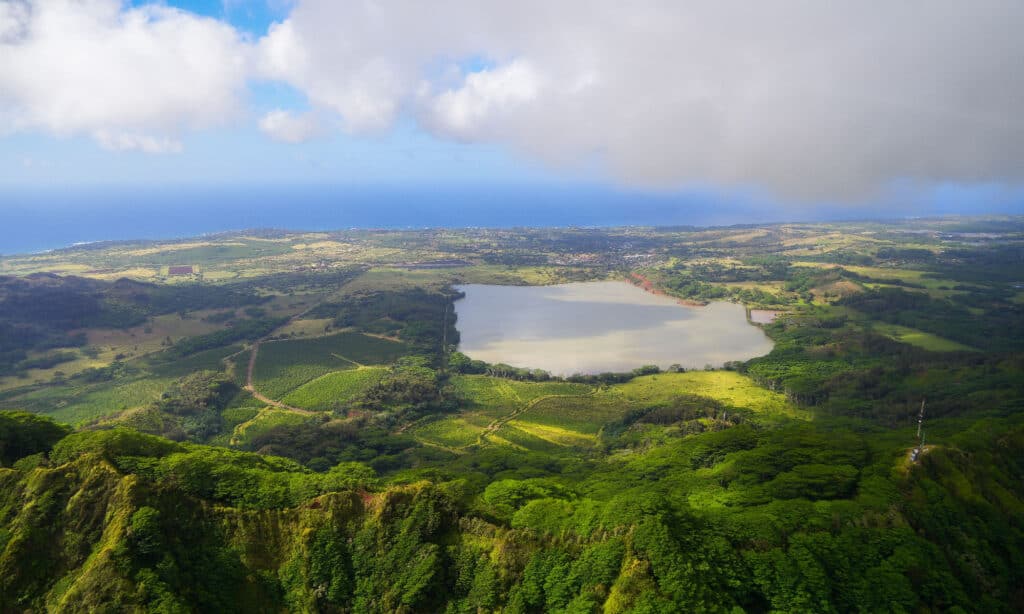
The exclusive Waita Reservoir provides an action-packed adventure with guided fishing tours and a zipline!
©Alexandre G. ROSA/Shutterstock.com
- Surface Area: 525 acres
- Max Depth: 23 feet
- Camping/Overnight Available: No
- Boating/Docks Available: No
- Swimming Permitted: No
- Fishing Permitted: Yes
- Best For: Exclusive, guided tours; zipline
Waita Reservoir goes by a few names. It’s also known as Hauiki Reservoir, Marsh Reservoir, or Kōloa Reservoir. Whatever the name, the lake is an exclusive, well-kept bit of a secret. Visitors will need to book a guided fishing tour or try the zipline available at the lake to get an up-close and personal experience.
The fishing is excellent, especially on a guided tour. Fish species in the water at Waita Reservoir include butterfly peacock bass, largemouth bass, smallmouth bass, peacock bass, blue tilapia, and koi. The bass and peacock bass at Waita Reservoir are catch-and-release only.
To get an even better view of Waita Reservoir, visitors can take a ride on the zipline available over the water. While zipping down the line, you might spot one of the many types of birds or wildlife that call the area home. Some of the wildlife visitors might spot include muscovy ducks, Hawaiian coots, Hawaiian gallinule, stilts, pheasant, Hawaiian boar, and jungle chickens.
Lake Wilson
- Surface Area: 400 acres
- Max Depth: 88 feet
- Camping/Overnight Available: No
- Boating/Docks Available: Yes
- Swimming Permitted: No
- Fishing Permitted: Yes
- Best For: Catch-and-release only; authentic Oahu experience
Also known as Wahiawā Reservoir, Lake Wilson is a large irrigation reservoir. It’s located near the city of Wahiawa. Lake Wilson visitors can also enjoy the surrounding Wahiawā Freshwater State Recreation Area for picnicking and other outdoor recreational activities.
Anglers looking for a fantastic freshwater fishing experience in Hawaii can’t do much better than Lake Wilson. It’s known to tourists and locals for offering a wide variety of fish. A few species known to swim Lake Wilson include largemouth bass, smallmouth bass, channel catfish, bluegill, tilapia, peacock bass, snakehead, oscar, and red devil.
Boats are permitted on the water, but only for fishing purposes, making canoes and kayaks a popular option. Flower lovers in the family shouldn’t miss the nearby Wahiawā Botanical Garden. Non-native parrots are known to be seen in the area, so keep your camera out!
Kahalu‘u Pond
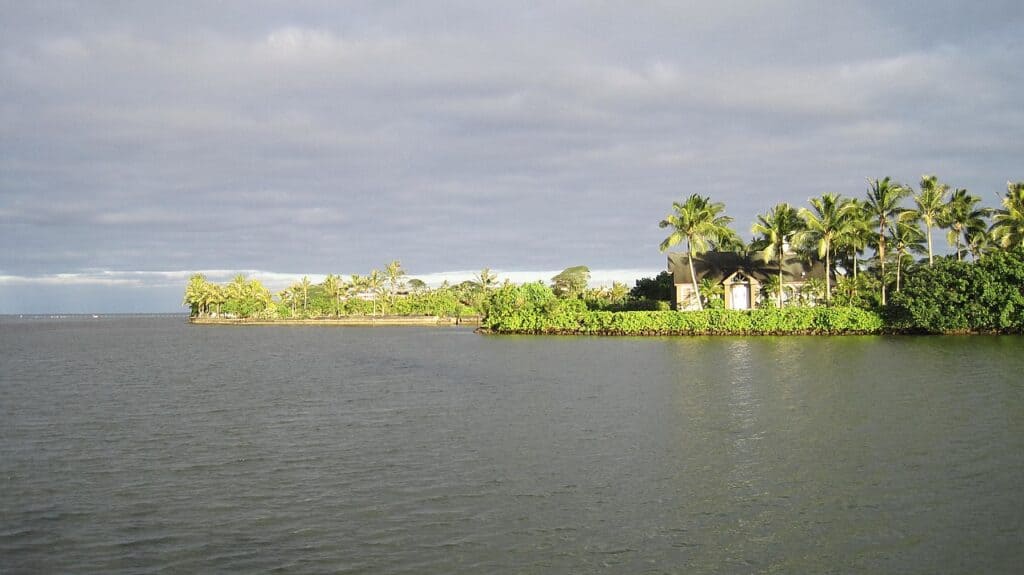
Kahalu‘u Pond listed on the National Register of Historic Places is one of the only surviving fishponds on Oʻahu
©Joel Bradshaw / I, the copyright holder of this work, release this work into the public domain. This applies worldwide. – Original
- Surface Area: 172 acres
- Max Depth: 5 feet
- Camping/Overnight Available: No
- Boating/Docks Available: No
- Swimming Permitted: No
- Fishing Permitted: Yes
- Best For: National Register of Historic Places; used for filming The Karate Kid: Part II; high-end wedding rentals
Originally called Kahouna Fishpond, Kahalu‘u Pond is one of the only surviving fishponds on Oʻahu. In 1973 the pond was spared destruction and added to the National Register of Historic Places. At one point in time, there were nearly one hundred fishponds on the island. Fishponds are an important part of ancient Hawaiian aquaculture.
Kahalu‘u Pond is a privately owned area, but it can be rented for weddings. The beautiful landscape and water were used for filming The Karate Kid: Part II in 1985. The amenities provided for ceremonies are first class and said to be out of this world.
Tourists can catch a glimpse of the fishpond from the nearby Kahaluu Beach. Birdwatchers can be on the lookout for a range of different species known to fly in the region. A few birds to look for are dove, sparrow, cardinal, white eye, and mynah.
Kanahā Pond – Kanahā Pond State Wildlife Sanctuary
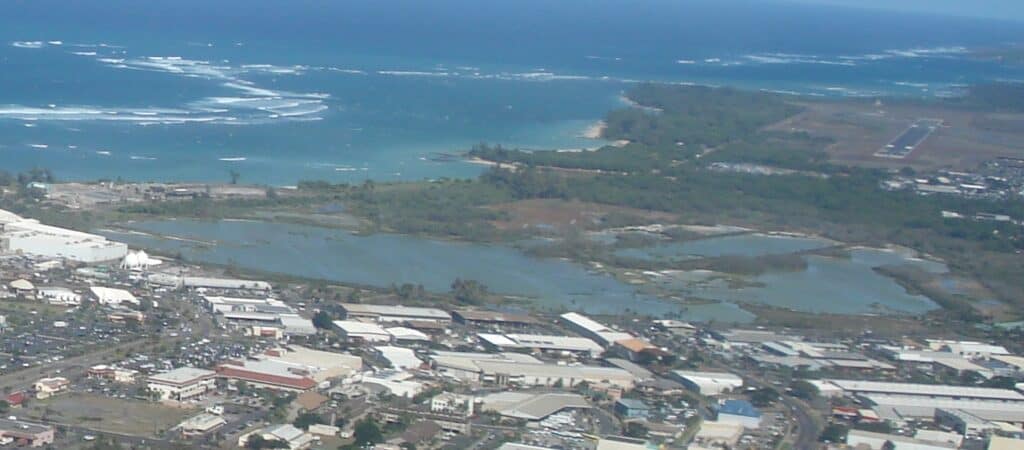
View over ninety different types of birds at Kanahā Pond and Kanahā Pond State Wildlife Sanctuary located in downtown Kahului
©derivative work: 293.xx.xxx.xx (talk) AirViewKahului.jpg: ideatrendz / Creative Commons – Original / License
- Surface Area: 143 acres
- Max Depth: N/A
- Camping/Overnight Available: Nearby hotels
- Boating/Docks Available: No
- Swimming Permitted: No
- Fishing Permitted: No
- Best For: National natural landmark
Tourists to Hawaii in the Kahului area should consider a visit to Kanahā Pond and Kanahā Pond State Wildlife Sanctuary. The pond is located in the heart of downtown Kahului and viewable even from a vehicle.
Anglers aren’t going to be reeling in a monster at Kanahā Pond unless they want to face serious fines or worse. This area is highly protected. The protected status provides home to a vast array of birds and other wildlife.
Just some of the 90 bird species that you might see at Kanahā Pond are teals, pigeons, dowitchers, sandpipers, plovers, tall and pink-legged Hawaiian black-necked stilt, brown koloa duck, white-billed Hawaiian coot, and seasonal Canadian geese.
He‘eia Fishpond
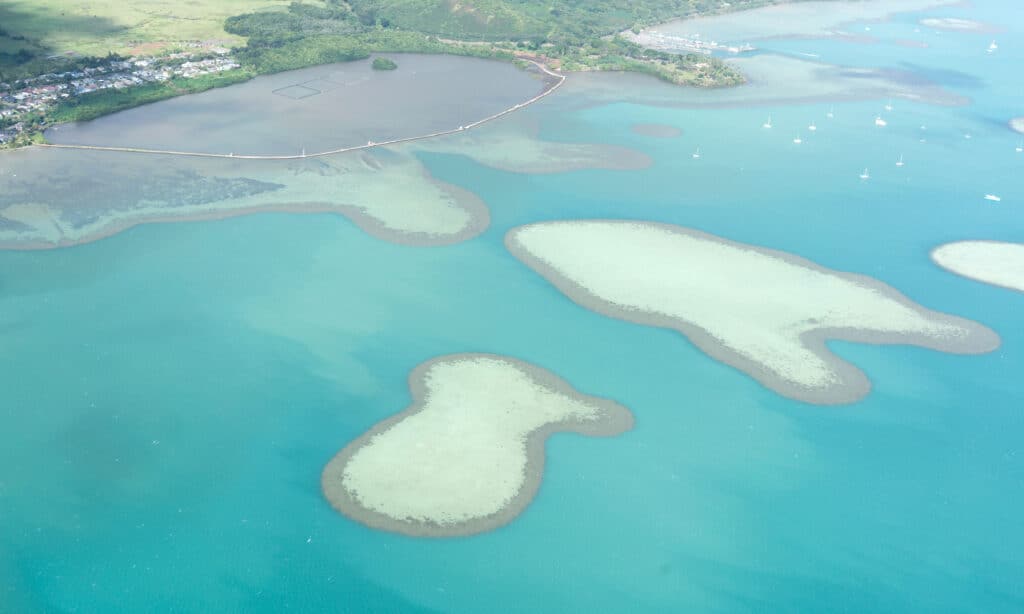
Take a walking tour of He‘eia Fishpond and learn about the deep Hawaiian history behind these fascinating phenomena
©iStock.com/violet-blue
- Surface Area: 88 acres
- Max Depth: N/A
- Camping/Overnight Available: No
- Boating/Docks Available: No
- Swimming Permitted: No
- Fishing Permitted: No
- Best For: Fishpond tour; He’eia State Park; birdwatching
He‘eia Fishpond is another preserved ancient Hawaiian fishpond. Its waters are not open to the public; however, it is possible to sign up for a tour or volunteer. It’s also possible to view the fishpond from neighboring He’eia State Park.
Even though anglers won’t be taking home any trophy fish from He‘eia Fishpond, it can certainly still be appreciated. Some of the typical fish species found in fishponds include moi, sixfinger threadfin, polydactylus sexfilis awaawa, Hawaiian ladyfish, elops hawaiensis, and chanos chanos. The fishpond is also home to several species of crab, shrimp, and eel.
He’eia State Park visitors may get the opportunity to snap a photograph of one of Hawaii’s endangered wetland birds, such as the Hawaiian gallinule, Hawaiian coot, and Hawaiian stilt.
Waiakea Pond

Waiakea Pond located within the Wailoa River State Recreation Area is a birdwatching hotspot
©iStock.com/ClaudineVM
- Surface Area: 25 acres
- Max Depth: 12 feet
- Camping/Overnight Available: Nearby hotels
- Boating/Docks Available: Wooden boats only, no gasoline engines
- Swimming Permitted: Yes
- Fishing Permitted: Yes
- Best For: Birdwatching hotspot
This pond is located within the Wailoa River State Recreation Area. The area is known to be a hotspot for viewing a wide range of endangered, rare, and unique bird species. Some of the many birds you can see include Hawaiian goose, lesser scaup, zebra dove, Hawaiian coot, Pacific golden-plover, black-crowned night-heron, house sparrow, yellow-billed cardinal, saffron finch, rock pigeon, spotted dove, and yellow-fronted canary.
In addition to the superior birdwatching opportunities, the pond is an excellent fishing spot. The pond is the Big Island’s largest natural lake, providing home to a number of fish species. The brackish water in Waiakea enables a unique variety of fish species, including bluefin trevally, striped bass, southern puffer, mullet, Ulua, aholehole, and Samoan crab.
Anglers can fish from shore or boat. Waiakea is restricted to wooden fishing boats without gas-powered engines.
Wailua Reservoir

Wailua Reservoir offers anglers the opportunity to fish freshwater on the island of Kauai surrounded by miles of vast ocean
©Jeff Whyte/Shutterstock.com
- Surface Area: 5 acres
- Max Depth: N/A
- Camping/Overnight Available: No
- Boating/Docks Available: No
- Swimming Permitted: No
- Fishing Permitted: Yes
- Best For: Largemouth bass fishing; birdwatching
Just a 15-minute drive from Wailua on the island of Kauai is Wailua Reservoir. The reservoir offers great bird watching and fishing opportunities to tourists and locals. No swimming or boating are permitted, and there are pretty strict fishing regulations.
Anglers can expect to find largemouth bass, tucunare, bluegill, and sunfish here. In addition to fishing in the reservoir, avid anglers can try the nearby Wailua River. Fish species there include crevalle jack, kariba tilapia, and bluefin trevally.
Birdwatchers are in for a treat. Be sure to grab your camera and identification book for a chance to spot the wide variety of birds that live in the area or pass through. Some of the species that you might find include red junglefowl, greater necklaced Laughingthrush, Hawaiian duck, western meadowlark, red-crested cardinal, rose-ringed parakeet, white-rumped shama, Japanese bush-warbler, Chinese hwamei, chestnut munia, and Hawaiian coot.
Seven Sacred Pools
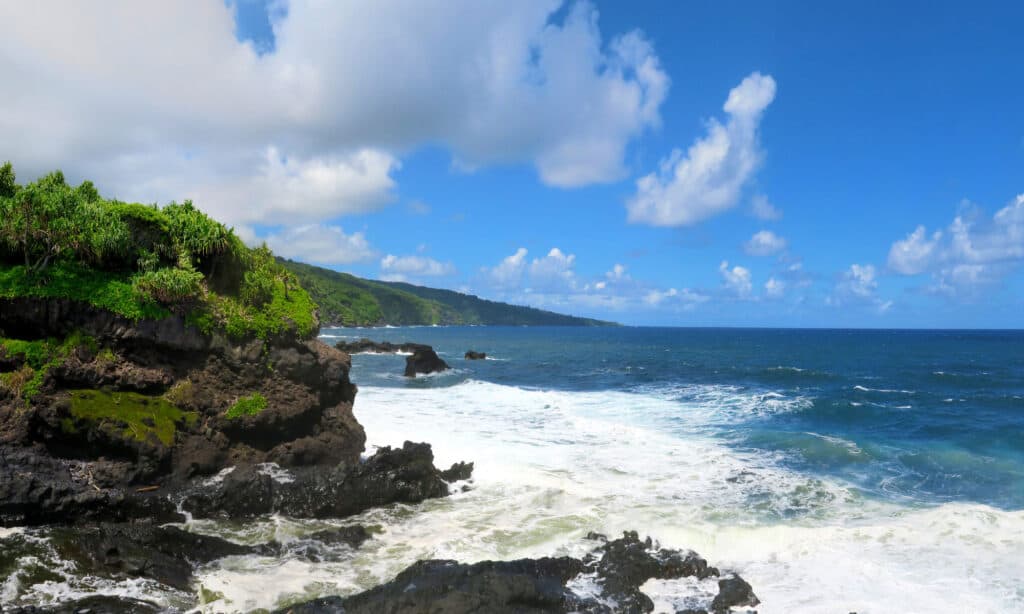
The Pools of ‘Ohe’o located in Haleakala National Park are one of Maui’s most popular swimming and diving destinations
©Big Joe/Shutterstock.com
- Surface Area: N/A
- Max Depth: N/A
- Camping/Overnight Available: No
- Boating/Docks Available: No
- Swimming Permitted: Yes
- Fishing Permitted: No
- Best For: Swimming; cliff jumping; photography; birdwatching
The Seven Sacred Pools aren’t technically a lake, reservoir, or fishpond. They are one of Hawaii’s most popular freshwater attractions, though. Pools of ‘Ohe’o is the official name of the series of waterfalls and water pools comprising this amazing feat of nature.
The sacred pools are part of the 30,000-acre Haleakala National Park. The pools and park make home to a range of native Hawaiian birds, insects, and other wildlife such as the Hawaiian wolf spider, Hawaiian yellow-faced bee, Haleakalā flightless moth, and Hawaiian happy-face spider.
Bird species likely to be seen in the area include ‘Apapane, ‘I‘iwi, ‘Amakihi, ‘Alauahio, Maui parrotbill, and Nēnē (the Hawaiian goose). With so much wildlife, the Haleakala National Park and Pools of ‘Ohe’o are an extremely popular destination for tourists and locals looking to dive, swim, and take in Hawaii’s natural beauty.
Lake Waiau
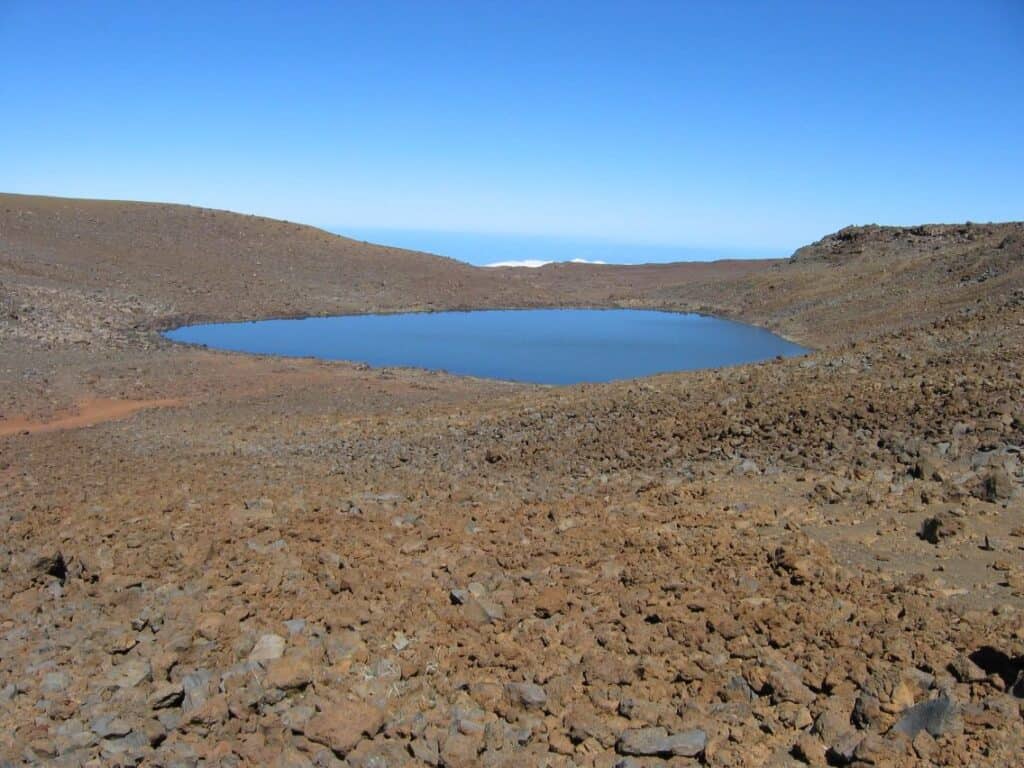
Lake Waiau, located high on Mauna Kea is an alpine lake perfect for hikers and nature photographers
©The original uploader was KarlM at English Wikipedia. / Creative Commons – Original / License
- Surface Area: 1.4 acres
- Max Depth: 8 feet
- Camping/Overnight Available: No
- Boating/Docks Available: No
- Swimming Permitted: No
- Fishing Permitted: No
- Best For: Hiking; photography; third-highest lake in U.S.; scientific anomaly
Located high in the slopes of the volcanic Mauna Kea is Lake Waiau. The alpine lake sits just above 13,000 feet, making it the third-highest lake in the United States. The surface area of the lake expands and contracts depending on different environmental factors.
Visitors will need to hike to reach the lake. The total amount of time required to walk to the lake is about an hour. The altitude can result in cold temperatures during certain times of the year, so bring appropriate clothing.
Lake Waiau doesn’t offer a resort-style of experience. It’s said the area resembles the moon’s surface. Don’t expect to find fishing, swimming, boating, or camping here. This is perfect for hikers and photographers looking for a unique experience viewing an alpine lake.
Violet Lake

Violet Lake is a small body of water that is home to the red Hawaiian damselfly
- Surface Area: 0.004 acres
- Max Depth: N/A
- Camping/Overnight Available: No
- Boating/Docks Available: No
- Swimming Permitted: No
- Fishing Permitted: No
- Best For: Majestic beauty; unique, hiking; one of the most sacred bodies of water in Hawaii
The small body of water called Violet Lake is steeped in traditional Hawaiian religion. Once thought to be the home of a Hawaiian lizard goddess, it’s regarded today more for its unique ecosystem, environment, and beauty.
The lake is located high in the West Maui Mountains in one of the wettest places in the entire world. The name comes from the unique deep-blue color of the water. The lake is home to the red Hawaiian damselfly and several other native Hawaiian plants and wildlife.
Because this body of water is small, so don’t expect a full-service experience here. This lake experience is more tailored towards hikers looking for a once-in-a-lifetime opportunity.
Up Next…
- The 15 Highest Elevation Lakes in the United States
- Discover the 9 Best National Parks to Visit in Hawaii
- How Many Volcanoes are in Hawaii?
- The 9 Best Lakes in Canada for Swimming
The photo featured at the top of this post is © iStock.com/Phil Davis
Sources
- State of Hawaii Division of Aquatic Resources / Accessed September 1, 2022
- Fishbrain / Accessed September 1, 2022
- AA-Fishing / Accessed September 1, 2022
- National Dams / Accessed September 1, 2022
- Food and Agriculture Organization of the United Nations / Accessed September 1, 2022
- To Hawaii / Accessed September 1, 2022
- State of Hawaii / Accessed September 1, 2022
- Maui Fishpond / Accessed September 1, 2022
- Paepae o He’eia / Accessed September 1, 2022
- Nā Kilo Honua o Heʻeia / Accessed September 1, 2022
- Holoholo Kōloa / Accessed September 1, 2022
- Maui Magazine / Accessed September 1, 2022
- Birds of Oahu / Accessed September 1, 2022
- National Park Service / Accessed September 1, 2022
- He'eia State Park / Accessed September 1, 2022
Thank you for reading! Have some feedback for us? Contact the AZ Animals editorial team.







